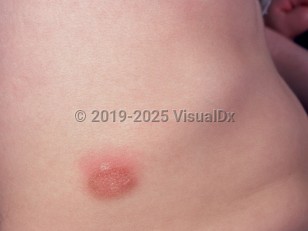Mastocytoma in Infant/Neonate
Alerts and Notices
Important News & Links
Synopsis

A mastocytoma is a form of cutaneous mastocytosis that may be present at birth or may develop in infancy. Cutaneous mastocytosis is a clonal disorder of mast cell accumulation. According to the World Health Organization (WHO) classification, cutaneous and systemic forms of mastocytosis are distinguished.
About 80% of pediatric mastocytosis cases present with cutaneous involvement, and 60% of all pediatric cutaneous mastocytosis cases present at birth.
Mastocytomas account for 10%-15% of pediatric cutaneous mastocytosis. Mastocytomas present with one or a few (up to 3) papules, plaques, or nodules (a diagnosis of urticaria pigmentosa is made if there are 4 or more lesions). The lesions may be pruritic and may swell spontaneously or after thermal, mechanical, or chemical stimulation. Thermal stimulation can occur after a bath, emotional stress, physical exertion, or with change in seasons. Mechanical stimulation can occur during surgery or following administration of vaccines. Chemical stimulation may be with foods or with topical or oral medication.
Mild systemic signs and symptoms may include flushing, bone pain, and headache. Hypotension / anaphylaxis, esophageal irritation, intestinal bleeding, and lymphadenopathy are less common with solitary mastocytomas but more frequently accompany other forms of cutaneous mastocytosis, such as urticaria pigmentosa and diffuse cutaneous mastocytosis.
About 80% of pediatric mastocytosis cases present with cutaneous involvement, and 60% of all pediatric cutaneous mastocytosis cases present at birth.
Mastocytomas account for 10%-15% of pediatric cutaneous mastocytosis. Mastocytomas present with one or a few (up to 3) papules, plaques, or nodules (a diagnosis of urticaria pigmentosa is made if there are 4 or more lesions). The lesions may be pruritic and may swell spontaneously or after thermal, mechanical, or chemical stimulation. Thermal stimulation can occur after a bath, emotional stress, physical exertion, or with change in seasons. Mechanical stimulation can occur during surgery or following administration of vaccines. Chemical stimulation may be with foods or with topical or oral medication.
Mild systemic signs and symptoms may include flushing, bone pain, and headache. Hypotension / anaphylaxis, esophageal irritation, intestinal bleeding, and lymphadenopathy are less common with solitary mastocytomas but more frequently accompany other forms of cutaneous mastocytosis, such as urticaria pigmentosa and diffuse cutaneous mastocytosis.
Codes
ICD10CM:
D47.01 – Cutaneous mastocytosis
SNOMEDCT:
404171008 – Mastocytoma
D47.01 – Cutaneous mastocytosis
SNOMEDCT:
404171008 – Mastocytoma
Look For
Subscription Required
Diagnostic Pearls
Subscription Required
Differential Diagnosis & Pitfalls

To perform a comparison, select diagnoses from the classic differential
Subscription Required
Best Tests
Subscription Required
Management Pearls
Subscription Required
Therapy
Subscription Required
References
Subscription Required
Last Reviewed:02/24/2020
Last Updated:04/02/2020
Last Updated:04/02/2020
Mastocytoma in Infant/Neonate

